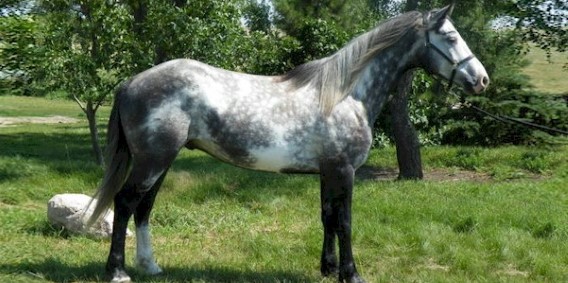Nokota horses are feral and semi-feral horses located in the
badlands of southwestern North Dakota in the United States. They get their name
from the Nokota Indian tribe that inhabited North and South Dakota.
Nakota horses are often blue roan, which is a color rare in
other breeds, although black and gray are also common. Other, less common,
colors include red roan, bay, chestnut, dun, grullo and palomino. Pinto
patterns such as overo and sabino occur occasionally.
They have an angular frame with prominent withers, a sloped
croup, and a low set tail.
There are two general types of Nokota horses. The first is
the traditional Nokota, known by the registry as the National Park Traditional
type. They tend to be smaller, more refined, and closer in type to the Colonial
Spanish Horse, and generally stand between 14 and 14.3 hands (56 to 59 inches,
142 to 150 cm) high.
The second type is known as the ranch-type or National Park
Ranch type. They more closely resemble early foundation type Quarter Horses,
and generally stand from 14.2 to 17 hands (58 to 68 inches, 147 to 173 cm).
Both types often exhibit an ambling gait, once known as the
Indian shuffle. Nokota horses are described as versatile and intelligent. They
have been used in endurance racing and western riding, and a few have been used
in events such as fox hunting, dressage, three day eventing, and show jumping.
They were developed in the southwestern corner of North
Dakota, in the Little Missouri River Badlands. Feral horses were first
encountered by ranchers in the 1800s, and horses from domestic herds mingled
with the original feral herds. Ranchers often crossbred local Indian ponies,
Spanish horses, and various draft, harness, Thoroughbred, and stock horses. The
goal was to develop make hardy, useful ranch horses.
In 1884, the HT Ranch, located near Medora, North Dakota,
bought 60 mares. The mares were from a Sioux Indian herd of 250 that was originally
confiscated from Sitting Bull and sold at Fort Buford, North Dakota in 1881.
Some of these mares were bred to the Thoroughbred racing stallion Lexington,
also owned by the HT Ranch.
By the early 1900s, the feral horse herds became the target
of local ranchers looking to limit grazing competition for their livestock.
Many horses were rounded up, and either used as ranch horses, sold for
slaughter, or shot. From the 1930s through the 1950s, federal and state
agencies worked with ranchers to remove horses from western North Dakota.
However, when Theodore Roosevelt National Park was established in the 1906,
during construction, a few bands of horses were accidentally enclosed within
the Park fence, and by 1960 these bands were the last remaining feral horses in
North Dakota. Nonetheless, the Park fought to eliminate these horses, and in
the 1970s won exemption from federal laws that covered other free roaming horse
management actions.
In the late 1970s, growing public opposition to the removal
of feral horses prompted management strategy changes, and today the herds
within the Theodore Roosevelt National Park are managed for the purposes of historical
demonstration. However, the Park added outside bloodlines in the 1980s with the
aim of modifying the appearance of the Nokota. The dominant herd stallions were
removed and replaced with two feral stallions from the Bureau of Land
Management’s Mustang herds, a crossbred Shire stallion, a Quarter Horse
stallion, and an Arabian stallion. At the same time that the stallion
replacements took place, a large number of horses from the park were rounded up
and sold at auction.
In 1993, the Nokota was declared the Honorary State Equine
of the state of North Dakota. In 1994, researchers conducted a study of the
horses in the park, and discovered that none of the horses in the park had
characteristics consistent with Colonial Spanish Horses. Since then, the horses
on the Kuntz ranch have been bred to maintain and improve their Spanish
characteristics. Nokota horses can be found in Pennsylvania, Minnesota, Montana,
and Oregon, as well as North Dakota.
Theodore Roosevelt National Park has continued thinning the
herd, with several roundups conducted throughout the 1990s and 2000s. In 2000,
the last horse to be considered of traditional Nokota type was removed from the
wild. The National Park Service currently maintains a herd of 70 to 110 horses.
We added a description of Nokota horses. If you have any
suggestions on how we can improve the description, please let us know.
